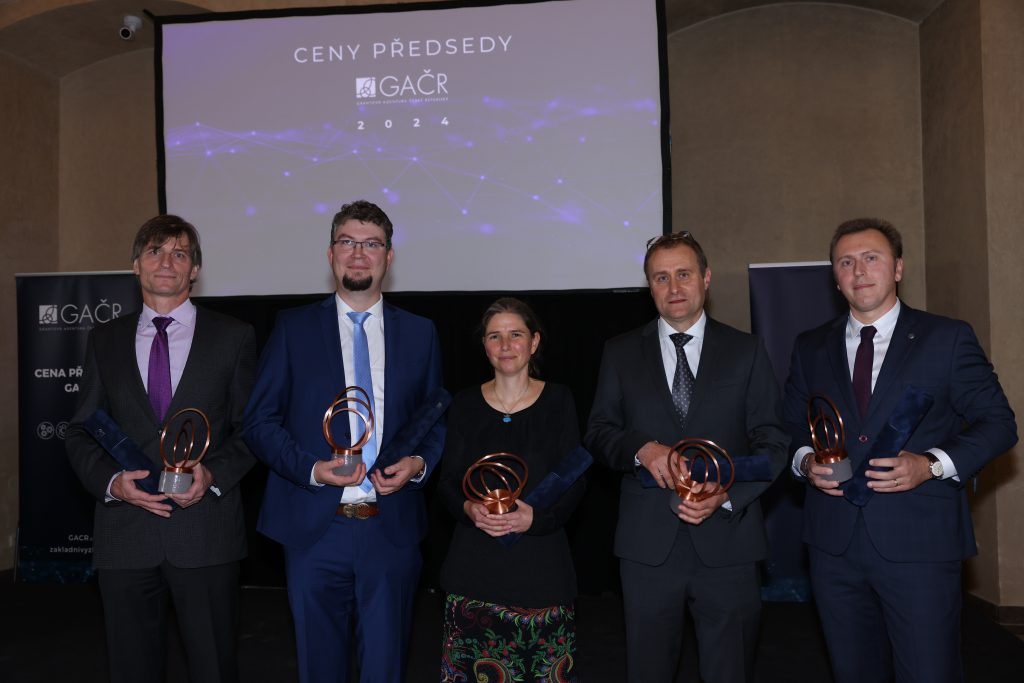
The President of the Czech Science Foundation (GACR) Petr Baldrian awarded the five best scientific projects this evening at the Strahov Monastery. The awarded basic research has significantly contributed to the deepening of knowledge in the given disciplines and opened the way to further practical application.
The winning projects and their results have contributed to the discovery of new alloys with unique properties, increased our ability to divert the orbits of potentially dangerous asteroids threatening the Earth, opened new pathways for cancer treatment research, but also focused on the link between poverty and ethical decision-making or plant chemistry strategies.
“Selecting five award-winning projects from dozens of top projects was very challenging this year: just like in the years before, there were many results that were reflected in the most prestigious scientific media. The selected projects benefit from prestigious international collaboration and also have the potential to extend into applied research. With their results, the project investigators show that it is possible to do world-class science in the Czech Republic and are an inspiration for future generations,” said the President of the Czech Science Foundation, Prof. Petr Baldrian.
The Czech Science Foundation President’s Award has been regularly awarded since 2003 in recognition of outstanding results achieved in grant projects completed in the previous year. Recipients are selected on the recommendation of several hundred scientists who evaluate projects funded by the Czech Science Foundation. The awards are presented in five areas of basic research: Technical Sciences, Physical Sciences, Medical and Biological Sciences, Social Sciences and Humanities, and Agricultural and Biological-Environmental Sciences.
This year, for the first time, the laureates received a trophy depicting the foundation’s motif along with their award. The trophy was created from recycled glass and 3D printing by designers from Plastenco design in cooperation with the Czech Science Foundation. “The design and production of a unique trophy linked to science and basic research is a highly prestigious matter for us. The dominant part is made up of circles inspired by the logo of the Czech Science Foundation, rendered in the colour of bronze. We have applied a small element of playfulness: the circles can be moved, taken out, bent and inserted according to one’s own imagination,” says Kateřina Sýsová, co-founder of the company.
The award ceremony was attended by representatives of the Minister for Science, Research and Innovation, the Ministry of Education, the Research, Development and Innovation Council, universities, the Czech Academy of Sciences and dozens of other distinguished guests.

Award-Winning Projects
Technical Sciences
Prof. Ing. Hanuš Seiner, Ph.D., DSc., Institute of Thermomechanics of the CAS
Laser and ultrasound to revolutionize materials engineering: Revealing hidden structures in alloys for new technologies (project: Advanced laser-ultrasonic characterization of structural transitions in metals – analysis beyond the homogeneity assumption)
Scientists have designed laser-ultrasonic methods to characterize newly developed generations of alloys, which often have complex microstructures and unusual elastic properties. These materials have a wide range of applications, for example in optical devices or joint implants. The project has also contributed to the discovery of several new alloys with unique properties.
Physical Sciences
Mgr. Petr Pravec, Dr., Astronomical Institute of the CAS
Asteroids on a collision course: How space probes and new discoveries help protect Earth from collision
project: Physical and dynamical properties of space mission target asteroids, and their evolutionary paths
Scientists have analyzed the physical properties and parameters of asteroids based on changes in their luminous flux. This has been crucial for space missions to these objects and the subsequent interpretation of the obtained data. They were also involved in the US DART mission, which tested technology to deflect potentially dangerous asteroids by impacting the asteroid Dimorphos.
Medical and Biological Sciences
Mgr. et Mgr. Dalibor Blažek, Ph.D., Masaryk University – CEITEC
An important enzyme in the fight against cancer: How CDK11 opens up new possibilities for cancer treatment
project: Characterization of kinase activity of cyclin-dependent kinase 11 (CDK11), an essential enzyme for the growth of cancer
Enzymes from the cyclin-dependent kinase (CDK) family control important functions in the cell. CDK-blocking substances are important in cancer research and treatment. Scientists have discovered that the overlooked enzyme CDK11 plays a key role in RNA editing. The substance OTS964, which has anti-cancer activity and blocks CDK11, prevents RNA editing in the cell. The research has revealed a new mechanism of RNA editing in the cell, providing new opportunities for cancer treatment research.
Social Sciences and Humanities
Doc. PhDr. Julie Chytilová, Ph.D., Economics Institute of the CAS
Poverty and behavior: How financial distress affects ethics and decision-making
project: Determinants of Pro-Social and Anti-Social Behavior: Field Experimental Evidence
Research among Ugandan farmers shows that poverty and financial distress lead to impatient behavior – people prefer immediate consumption and do not want to wait for longer-term results. This can worsen their future situation and keep them in a ‘vicious cycle of poverty’. Financial distress also increases the risk of unethical behavior. Research findings suggest that even short-term assistance can improve the decision-making and economic situation of the poor in the long term.
Agricultural and Biological-Environmental Sciences
RNDr. Martin Volf, Ph.D., Biology Centre of the CAS
How insect invaders shape the chemical defences of plants: Secrets of the diverse chemical makeup of willows
project: Why is there such high diversity of chemical defences: role of insect herbivory in promoting chemical diversity in willows
Plants produce hundreds of thousands of chemicals. They are able to tailor their production to survive in different environments. In harsh climates, they produce high concentrations of a narrow range of substances, while when insects attack, they produce a large number of chemicals, including those that attract the predators of the insects in question. Research has revealed how the chemical strategies of plants evolve and how the vast amounts of substances they produce are created.